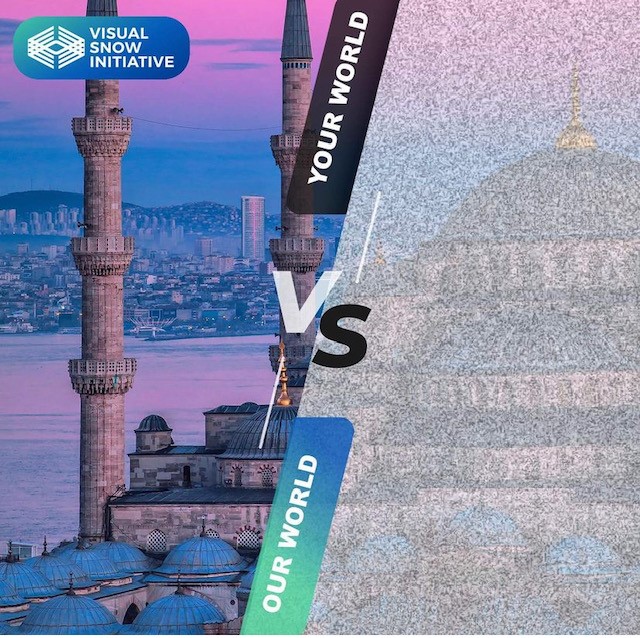Half a million Australians who see the world like it is an old snowy TV screen will soon have access to a new scientifically proven treatment for their vision problem which was only named in 2013.
Visual Snow Syndrome is a condition that dramatically impairs vision in about 1 in 50 people.
Sufferers typically see the world in black and white or coloured dots – much like they are watching a snowy TV screen – or have excessive floaters, have significant discomfort in bright light, and impaired night vision. Other symptoms can be non-visual, ranging from ringing in the ears, dizziness and tingling body parts, to even feeling detached from yourself, and sleep disorders. Some sufferers who are born with the syndrome may presume their vision is normal. For others, it has occurred later in life after suffering trauma, illness or a reaction to medication.
Visual Snow Syndrome (VSS) was first described in 1995, then only given its name in 2013, and many sufferers have been subjected to years of testing for illnesses they have not had, or told they just have to live with it.
A new treatment published in the medical journal Frontiers in Neurology has been proven through research conducted by two US-based optometrists, Dr Charles Shidlofsky and Dr Terry Tsang, who are associates of the Visual Snow Initiative that was founded to provide resources and hope to sufferers.
They will outline the treatment and present other VSS education to Australian
optometrists at the Australasian College of Behavioural Optometrists conference in Sydney on March 25 & 26.
While it is not a cure for the syndrome, and medications do not work for many sufferers, it is the first physical treatment that has dramatically reduced the symptoms for all those involved in the research, results which have lasted for more than a year.
Steve Leslie, Optometrist and Executive Director at Australasian College of Behavioural
Optometrists, says:
“This treatment involves an hour a week of vision therapy with an experienced and Visual Snow Initiative (VSI) -accredited optometrist, together with at-home vision activities completed on five days of the week for twelve weeks. While it is not a cure, it is the only known treatment to date for symptoms of the syndrome and can go a long way to reducing the snowy vision symptoms of the 1 in 50 Australians who suffer from Visual Snow Syndrome, and the improvements can be felt in as little as six weeks.
“While many people with visual snow cope without major interference to their lives, many sufferers can find it problematic to drive, read, use a phone or computer, or simply leave their house to enjoy nature or to catch up with friends at night. For some people, it can affect mental health and interfere with their success at school or work.
“People who think they may have VSS should book a comprehensive examination with a VSI- accredited optometrist who has advanced education and experience in visual snow, to determine if they have visual snow or another similar condition, and to discuss the options for treatment. They can find an optometrist in their area by visiting www.acbo.com.au

![5 Reasons You Should Travel Alone Airplane [image source: chau nguyen/ http://thedevilhatessweatpants.blogspot.com.au ], crowd ink, crowdink, crowdink.com, crowdink.com.au](https://crowdink.com/wp-content/uploads/2016/08/Chau-airplane-218x150.jpg)




























![5 Reasons You Should Travel Alone Airplane [image source: chau nguyen/ http://thedevilhatessweatpants.blogspot.com.au ], crowd ink, crowdink, crowdink.com, crowdink.com.au](https://crowdink.com/wp-content/uploads/2016/08/Chau-airplane-100x70.jpg)


